Problem 1) The term market failure refers to
a. a situation where there are only two producers in the market.
b. a situation where there are too many firms in the market.
c. a situation in which the market on its own, fails to allocate resources efficiently.
d. a situation where a firm is forced out of business because of losses.
e. a situation in which imposition of a tax causes a deadweight loss.
Problem 2) Let TC denote total cost, Q the quantity produced, FC fixed cost, VC variable cost and MC marginal cost. Then, the average total cost equals:
a. (FC + VC) / change in Q
b. MC / Q.
c. (MC x Q) + FC.
d. VC / Q.
e. (FC + VC) / Q
Problem 3) If Good X is normal but Good Y is inferior, then the income-consumption Line will:
a. be a horizontal line.
b. be a vertical line.
c. have a negative slope.
d. have a positive slope.
e. be indeterminate without information on prices.
Problem 4) Average total cost is greater than average variable cost when:
a. the marginal cost is decreasing.
b. the marginal cost is zero.
c. marginal cost equals average variable cost.
d. marginal cost equals average total cost
e. fixed costs are positive.
Problem 5) If the average tax rate increases as income increases, the tax is a(n)
a. progressive tax.
b. regressive tax.
c. proportional tax.
d. flat tax.
e. efficient tax.
For the next TWO questions consider the following information:
Consider a market where demand is P=10-2Q. There is a positive consumption externality of $2.50/unit of consumption. In the answers, Qm=market equilibrium quantity, Pm=market price, Qs=socially optimal quantity, Ps=socially optimal price.
Problem 6) Calculate the market and socially optimal equilibrium if supply is equal to Q=4.
a. Qm=4, Pm=4; Qs=4, Ps=4.50
b. Qm=4, Pm=2; Qs=4, Ps=2
c. Qm=4, Pm=2; Qs=4, Ps=4.50
d. Qm=4, Pm=4; Qs=2, Ps=4
e. Qm=4, Pm=2; Qs=2, Ps=2
Problem 7) Consider the market if supply is P=Q/2. Calculate the market equilibrium and the socially optimal equilibrium.
a. Qm=4, Pm=4; Qs=4, Ps=4
b. Qm=4, Pm=2; Qs=5, Ps=2.5
c. Qm=4, Pm=2; Qs=4, Ps=2.5
d. Qm=4, Pm=4; Qs=5, Ps=4
e. Qm=4, Pm=2; Qs=4, Ps=2.5
Problem 8) Which of the following is NOT true for the Coase Theorem?
a. We can get the socially efficient outcome with bargaining even if there is an externality going on.
b. Property rights must be well defined.
c. There should be low or no transaction cost.
d. Only small number of people should be involved with the externality.
e. The government can induce the efficient outcome by order.
Problem 9) Suppose the marginal social benefit of an action is greater than the marginal private benefit. Then there is ________, and the equilibrium quantity in the market is ________ than the efficient quantity.
a. positive externality, smaller
b. positive externality, greater
c. negative externality, smaller
d. negative externality, greater
e. public good, smaller
Problem 10) Which of the following facts about normal indifference curves is false?
a. Indifference curves slope downwards.
b. Indifference curves never intersect.
c. The slope of an indifference curve is constant.
d. Indifference curves are bowed towards the origin.
e. Each Indifference curve represents a different but constant level of satisfaction.
Problem 11) The marginal tax rate is:
a. total taxes paid divided by taxable income.
b. taxable income divided by total taxes paid.
c. the change in taxes paid divided by taxable income.
d. the change in taxes paid divided by the change in taxable income.
e. total taxes paid divided by the change in taxable income.
Problem 12) Which of the following comprises the largest percentage of federal spending?
a. Interest Payments
b. Income Security
c. Healthcare
d. National Defense
e. Social Security
Problem 13) If the total cost curve is upward sloping over some range of output with an increasing slope, then this fact must reflect:
a. Decreasing average variable cost
b. Increasing fixed costs.
c. Increasing variable costs.
d. both (a) and (b).
e. both (b) and (c).
Use the following graph for the next TWO questions. (Note: MSC=marginal social cost, MPC=marginal private cost.) NOTE: Figure not necessarily to scale!!!
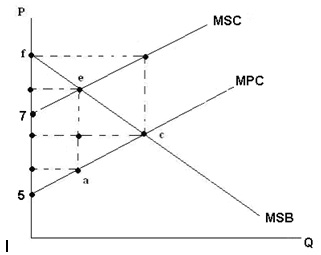
Problem 14) You are told the equilibrium at point c has P=6, Q=2. Consumer surplus in the market equilibrium is:
a. $2
b. $3
c. $4
d. $5
e. It cannot be determined from the information given.
Problem 15) To remedy the problem here, the government could impose a tax. What is the deadweight loss from the tax that results in the socially optimal quantity?
a. $2
b. $2/3
c. $4/3
d. $8/3
e. $10/7
Use the following table about donut production in “Square donuts & Co.” to answer the next TWO questions.
Output Total Costs
10 5
20 15
30 30
40 50
50 75
60 105
70 140

Problem 16) If you only had the table to go by, which of the above figures best represents Square Donuts & Co’s marginal cost (as usual, on the horizontal axis we have the level of production and on the vertical axis the marginal cost):
a. Figure A
b. Figure B
c. Figure C.
d. Figure D.
e. None of them.
Problem 17) Regarding fixed costs, we can conclude that:
a. they are increasing.
b. they are decreasing.
c. they are constant.
d. they are 5.
e. they are less than 5.
For the next THREE questions consider the following figure.
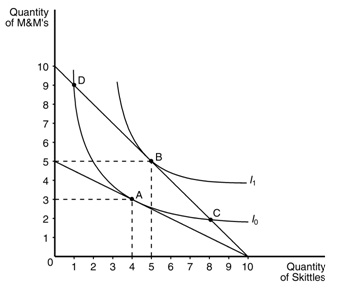
Problem 18) Assume that the consumer depicted in the figure has an income of $20. The price of Skittles is $2 and the price of M&M’s is $4. This consumer will choose a consumption bundle where the marginal rate of substitution is
a. 2.
b. 2/3.
c. 1/2.
d. 1/3.
e. 1
Problem 19) Assume that the consumer depicted in the figure has an income of $20. The price of Skittles is $2 and the price of M&M’s is $2. This consumer will choose to optimize by consuming
a. bundle A.
b. bundle B.
c. bundle C.
d. bundle D.
e. none of above.
Problem 20) Assume that the consumer depicted in the figure faces prices and income such that she optimizes at point B. According to the graph, what change forces the consumer to move to point A?
a. a decrease in the price of Skittles.
b. a decrease in the price of M&M’s.
c. an increase in the price of Skittles.
d. an increase in income.
e. an increase in the price of M&M’s.
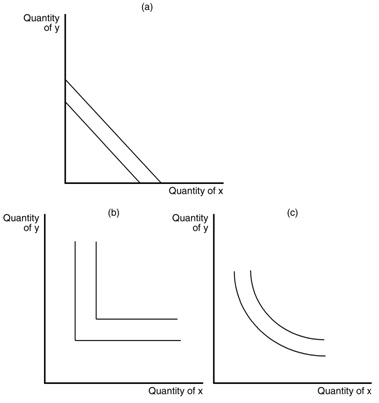
Problem 21) In the figure directly above, which of the graphs shown represent indifference curves for perfect substitutes?
a. graph (a)
b. graph (b)
c. graph (c)
d. All of the above are correct.
e. None of the above are correct.
Problem 22) Someone is definitely a free rider if he
a. produces a good and never gets paid for it.
b. consumes a good without paying for it.
c. enjoys leisure more than work at the margin.
d. generates externalities in production.
e. does not pay taxes.
Refer to the following information for the next THREE questions.
Ivan has decided to start a new business producing homemade beer. During the first year of his business, Ivan sold 15000 cans of beer for $4/can. The technology of production Ivan is using has a constant average variable cost of $2/can with a fixed cost of $5000.
Problem 23) Ivan’s profit from the first year of production was:
a. $0
b. $30000
c. $25000
d. $60000
e. - $10000
Problem 24) Which of the following best represents Ivan’s cost function?
a. TC = 15000 + 4*Q
b. TC = 5000 + 2*Q
c. TC = 5000 + 4*Q
d. TC = 4*Q
e. TC = 5000
Problem 25) According to the technology Ivan is using to produce beer, we could say that the marginal cost of production is:
a. increasing
b. decreasing
c. increasing when the production is low, and decreasing when the production is high.
d. decreasing when the production is low, and increasing when the production is high.
e. constant
Problem 26) Indifference curves graphically represent
a. an income level sufficient to make an individual happy.
b. the constraints faced by individuals.
c. the money individual could have.
d. the relative price of commodities.
e. an individual's preferences.
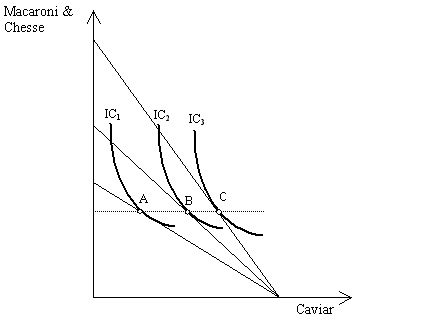
Problem 27) According to the figure, it is possible to say that:
a. The demand for Macaroni & Cheese is perfectly inelastic.
b. The demand for caviar is perfectly inelastic.
c. The demand for Macaroni & Cheese is perfectly elastic.
d. The demand for Caviar is a perfectly elastic.
e. The price of caviar is changing.
The next THREE questions are based on the following: Mike has $20 in income, and consumes two goods, X and Y. The price of X is $2 and the price of Y is $4.
Problem 28) The equation of Mike’s budget line is:
a. 4X+2Y=20.
b. 2X+4Y=20.
c. 4X+2Y=10.
d. 2X+2Y=30.
e. 4X+2Y=30.
Problem 29) Which of the following points could never be an optimal bundle for Mike?
a. (X,Y)=(0,5)
b. (X,Y)=(8,1)
c. (X,Y)=(5,2.5)
d. (X,Y)=(10,0)
e. (X,Y)=(5,3)
Problem 30) If Mike’s optimal bundle is at (X,Y)=(4,3), then the slope of his indifference curve at this bundle is:
a. -2
b. 1/2
c. –1/2
d. 1/4
e. –1/4
Consider the following graph for the next TWO questions.
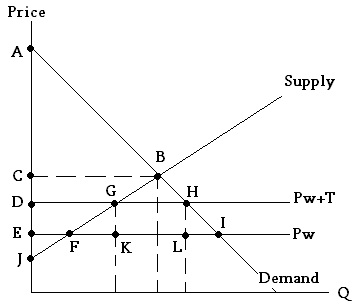
Suppose demand is P=10-Q, and supply is equal to P=Q+2. If we open the economy to trade, the price will be the world price, Pw=$3. IF a tariff of $T/unit imported is imposed, the market price would then be Pw+T.
Problem 31) Which of the following areas best describes the consumer surplus in the open economy with no tariff?
a. ABC
b. AHD
c. AIE
d. CBJ
e. ABJ
Problem 32) Suppose a tariff of $1/unit is imposed. The sum of consumer and producer surplus, then, is:
a. $2
b. $18
c. $20
d. $36
e. $41
Consider the following table for the next THREE problems:
Quantity
(lamps) Marginal benefit for Mike Marginal benefit for Joe Marginal benefit for Sam
1 4 3 5
2 3 2 4
3 2 1 3
4 1 0 2
5 0 0 1
Mike, Joe, and Sam are roommates. They need lamps for their common living room. Lamps in their living room satisfy the characteristics of a pure public good for these roommates. The marginal benefit that each individual receives (in dollar terms) from varying numbers of lamps in the living room is given in the table above.
Problem 33) The marginal benefit of the second lamp to this group of roommates taken as a whole is
a. 10.
b. 13.
c. 9.
d. 17.
e. 2.
Problem 34) If a lamp costs $3 in the market, the efficient number of lamps for the common living room is:
a. 2.
b. 3.
c. 4.
d. 5.
e. Cannot tell from the information available.
Problem 35) To provide the efficient number of lamps Mike will be paying____, Joe will be paying ____ while Sam will be paying____.
a. $4; $0; $8.
b. $4; $4; $8.
c. $1; $0; $2.
d. $1; $1; $1.
e. $6; $0; $6.
Problem 36) If a firm’s costs are completely specified by the equation TC=5Q2, where TC is total costs, then fixed costs are:
a. 0.
b. 5.
c. 5Q.
d. 5Q2.
e. None of the above.
Problem 37) A good that is rival but non-excludable is:
a. A common resource.
b. A complement.
c. A public good.
d. A private good.
e. None of the above.
Use the following figure for the next TWO questions.
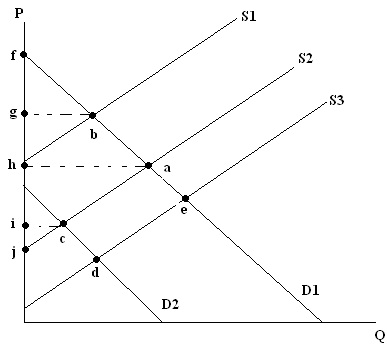
Problem 38) If the relevant market supply and demand curves are S2 and D1, and there is a negative production externality, then the market equilibrium is at:
a. Point a.
b. Point b.
c. Point c.
d. Point d.
e. Point e.
Problem 39) If the relevant market supply and demand curves are S3 and D1, and there is a negative consumption externality (and no production externality) for every unit consumed, which of the following statements could be correct?
a. The socially optimal equilibrium is at point a.
b. The socially optimal equilibrium is at point b.
c. The socially optimal equilibrium is at point c.
d. The socially optimal equilibrium is at point d.
e. The socially optimal equilibrium is at point e.